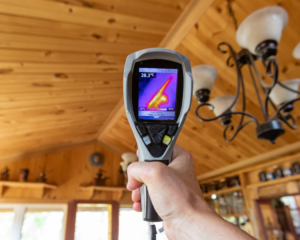By Ann Schwend
 Some home inspections include technology that can detect where energy is lost and how a home’s efficiency can be increased.
Some home inspections include technology that can detect where energy is lost and how a home’s efficiency can be increased.
As Montana grapples with how to address its ongoing housing crisis, it is important to connect the dots between how responsible planning can protect our climate and how quality and affordable housing can impact our environment.
There are environmental costs of developing homes and communities at greater and greater distances from city centers, work, schools, and utilities. Cities should be designed to accommodate and safely house more people in less space, which helps conserve community resources and maintain open space, wildlife habitat, and clean water. Low density sprawl is expensive to build and maintain, increases carbon emissions, requires more energy and has a direct impact on the right to a clean and healthful environment for all Montanans.
What’s Infill and How is it a Climate Issue?
As an environmental organization, MEIC’s priority is to discourage sprawl, while simultaneously supporting incentives to appropriately increase infill and density in urban areas. Infill can be a controversial topic, because it refers to increasing the amount of people living in urban spaces. This often manifests as adding apartments, accessory dwelling units (ADUs), or multi-family units like duplexes in areas traditionally filled with single-family homes.
Some who support climate action might be uncertain about infill, as they worry about how it may impact the character of their neighborhood and property values. Not only is infill sometimes resisted by existing neighborhoods, some developers feel that restrictive municipal zoning regulations and smaller project sizes can make the return on urban investments less attractive. In addition, the lack of available housing stock and building locations has pushed many workers to move to more affordable areas outside existing urban centers, often requiring them to commute into work.
Accommodating a growing population while maintaining open space and providing homes for people to live closer to work is vital for reducing sprawl, decreasing vehicle emissions, and building sustainable communities. When new homes and buildings are built on undeveloped land, there are cascading consequences: roads must be created and maintained; sewer, water, and electricity infrastructure must be increased or homes will have to rely on wells and septic systems; school buses must venture out farther; residents increasingly rely on automobiles; and wildlife habitat and farmland is lost. Low density sprawl increases emissions and is a strain on taxpayers, electricity transmission, and water and wastewater management.
Carving out small parcels of land for “green acres”-style living outside of cities creates challenges in the wildland urban interface, including infringing on wildlife habitat and increasing wildfire risk, changing the hydrology of our valleys, and consuming valuable farmland and open space that is important for the future stability of our ecosystems. Sprawling into the hinterlands is not an ecologically sustainable growth pattern; once it is developed, it is extremely difficult to go back. Thus, it is critical to consider the cumulative economic, social, and ecological costs of spreading out and how to encourage more development to occur within existing urban areas.
What one community does – or does not do – in terms of zoning reform impacts a larger area than just what has been zoned, creating a statewide problem that may require a statewide solution. MEIC is a strong advocate of local decision-making, but if some of the most impacted and fastest growing communities do not have the political will to adapt zoning reforms to allow for increased density, then new homes will be built on the outskirts or in bedroom communities. This pushes commuters into the surrounding communities, fracturing the connection between where they live and where they work.
Proactive and Cumulative Planning
Current land use planning approaches tend to be reactive and compartmentalized, rather than proactive and cumulative. Cities and counties are required to have growth policies and update them every five years, but these plans can become outdated if they aren’t updated regularly and neighboring jurisdictions don’t coordinate. In most cases, cities and counties each have their own planning departments, creating a piecemeal approach to many fast-growing regions rather than a coordinated vision for long term sustainable development practices.
In counties, subdivision review often occurs as each project is proposed, with the level of environmental scrutiny and public involvement dependent on the number of proposed lots in a project. Unfortunately, this individualized review process can gloss over the cumulative impacts of multiple projects, especially in regard to water resources.
How Housing Fits In
MEIC’s long history of working on energy issues has always included a focus on energy efficiency, affordability, and generation. Residential buildings are a key component of how Montana can take meaningful climate action and ensure that its residents have safe, comfortable, and affordable places to live.
Buildings account for almost one-third of global carbon emissions. In the U.S., 43% of total energy use is for heating and cooling buildings, and the residential and commercial sectors are responsible for about 13% of greenhouse gas emissions. It’s critical that buildings are designed to be as energy efficient as possible from the start.
Energy-efficient building codes and regulations help reduce energy use in new and renovated buildings. Requirements for improved insulation, energy-efficient windows, and better HVAC systems can reduce the amount of energy used in a building. In turn, this results in lower energy costs over the lifetime of the building or home, and reduced indoor air pollution and climate-changing pollution.
Quality, affordable housing located in urban areas represents an intersection between environmental advocacy and equity that is vital for Montana. With a better understanding and a more comprehensive approach to planning, Montana can work toward sustainable communities that are good for people, wildlife, water, and the climate.
This article was published in the June 2023 issue of Down To Earth.

